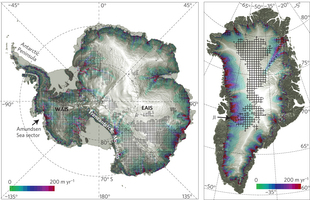‘Horrible’ sea level rise of more than 3 feet plausible by 2100, experts say
Melting glaciers in Antarctica and Greenland may push up global sea levels more than 3 feet by the end of this century, according to a scientific poll of experts that brings a degree of clarity to a murky and controversial slice of climate science. Such a rise in the seas would displace millions of people from low-lying countries such as Bangladesh, swamp atolls in the Pacific Ocean, cause dikes in Holland to fail, and cost coastal mega-cities from New York to Tokyo billions of dollars for construction of sea walls and other infrastructure to combat the tides. “The consequences are horrible,” Jonathan Bamber, a glaciologist at the University of Bristol and a co-author of the study published 6 January 2013 in the journal Nature Climate Change, told NBC News. […] Bamber and colleague Willy Aspinall attempted to find clarity in the chaos using a scientific polling technique common in fields such as predicting earthquakes and volcanic eruptions, but until now not applied to climate science. The pair sent 26 of the world’s leading glaciologists a series of questions about the behavior of the Antarctic and Greenland ice sheets. About half replied to the survey in 2010. The respondents were polled again in 2012 to assess the robustness of their answers. Bamber said this type of approach is “a lot more than an opinion poll.” The experts were handpicked to get a representative perspective of world leaders from the ice sheet modeling and observational fields. “We analyzed the results in a very systematic, rigorous, and statistically robust way,” he added. The median estimate from the experts is that the melting ice sheets will contribute 1 foot (29 centimeters) to sea level rise by the year 2100 with a 5 percent chance their contribution could exceed 2.8 feet (84 centimeters). When the effect of thermal expansion (water expands as it warms) is taken into account, the high-end estimate is more than 3 feet (1 meter). The estimates are higher than the controversial figures in the 2007 report from the Intergovernmental Panel on Climate Change (IPCC) of up to 23 inches (59 centimeters) and higher than the unpublished estimates being prepared for the next IPCC report, said Bamber, who is a review editor for that document and has seen the estimates. The discrepancy likely reflects added weight given to recent studies that indicate glacier melt has accelerated in recent years in Antarctica and Greenland, and that the West Antarctic ice sheet could partially collapse by the end of this century. “The numbers we are getting out of our elicitation reflect the fact that the world leaders in this field are now cognizant of the fact that the ice sheets are quite responsive and, in particular, there is a potential for them to make a really quite dramatic contribution,” Bamber said. [more]
‘Horrible’ sea level rise of more than 3 feet plausible by 2100, experts say
